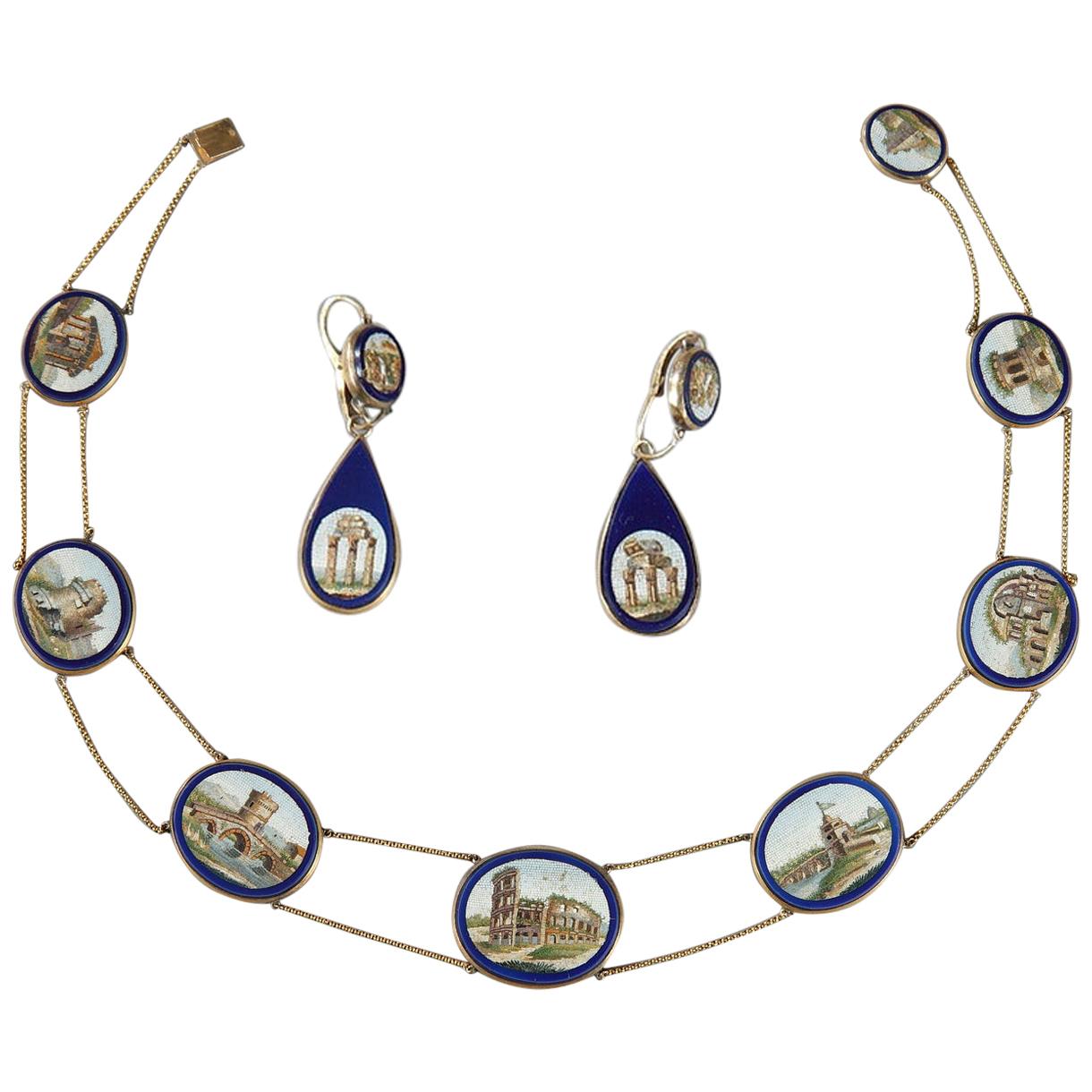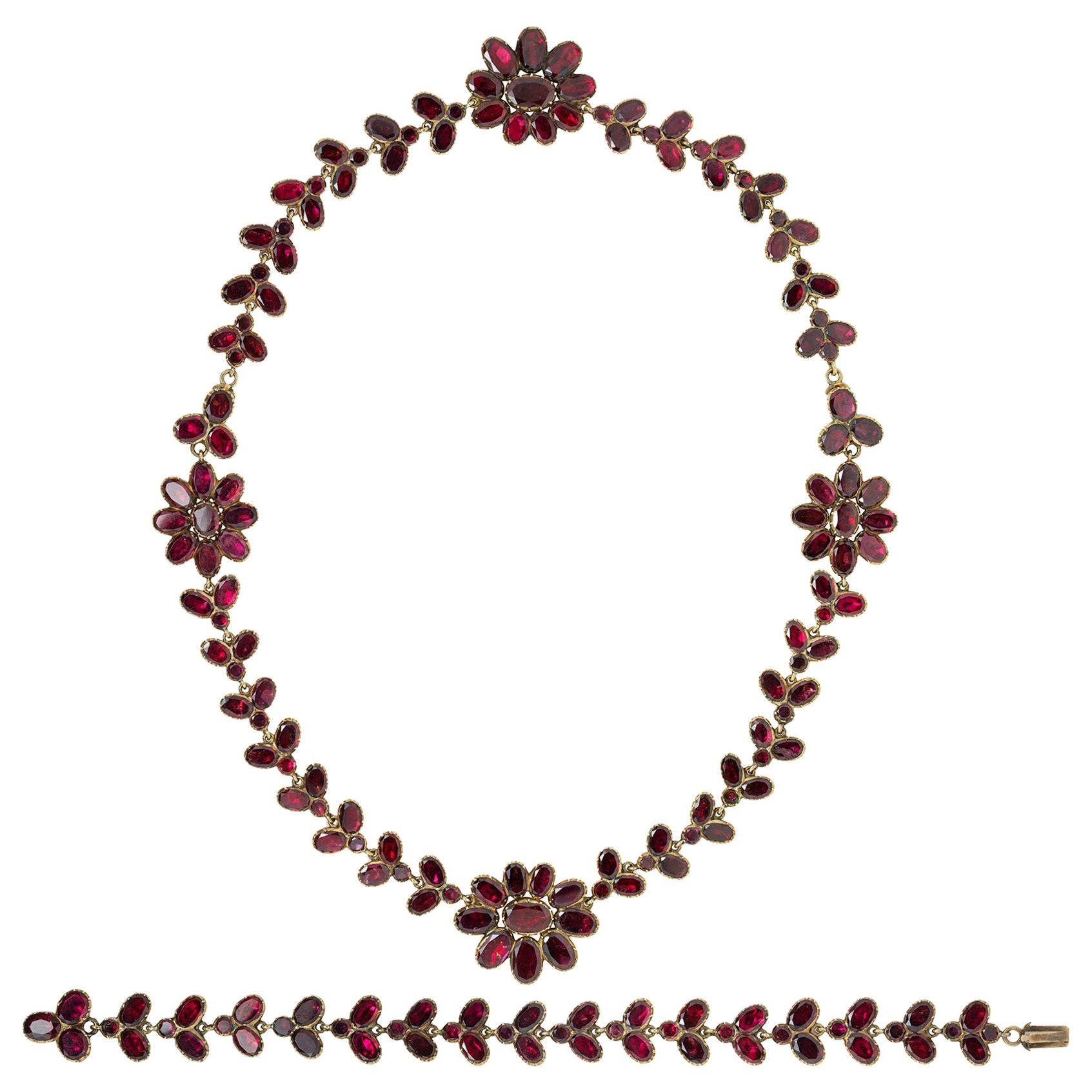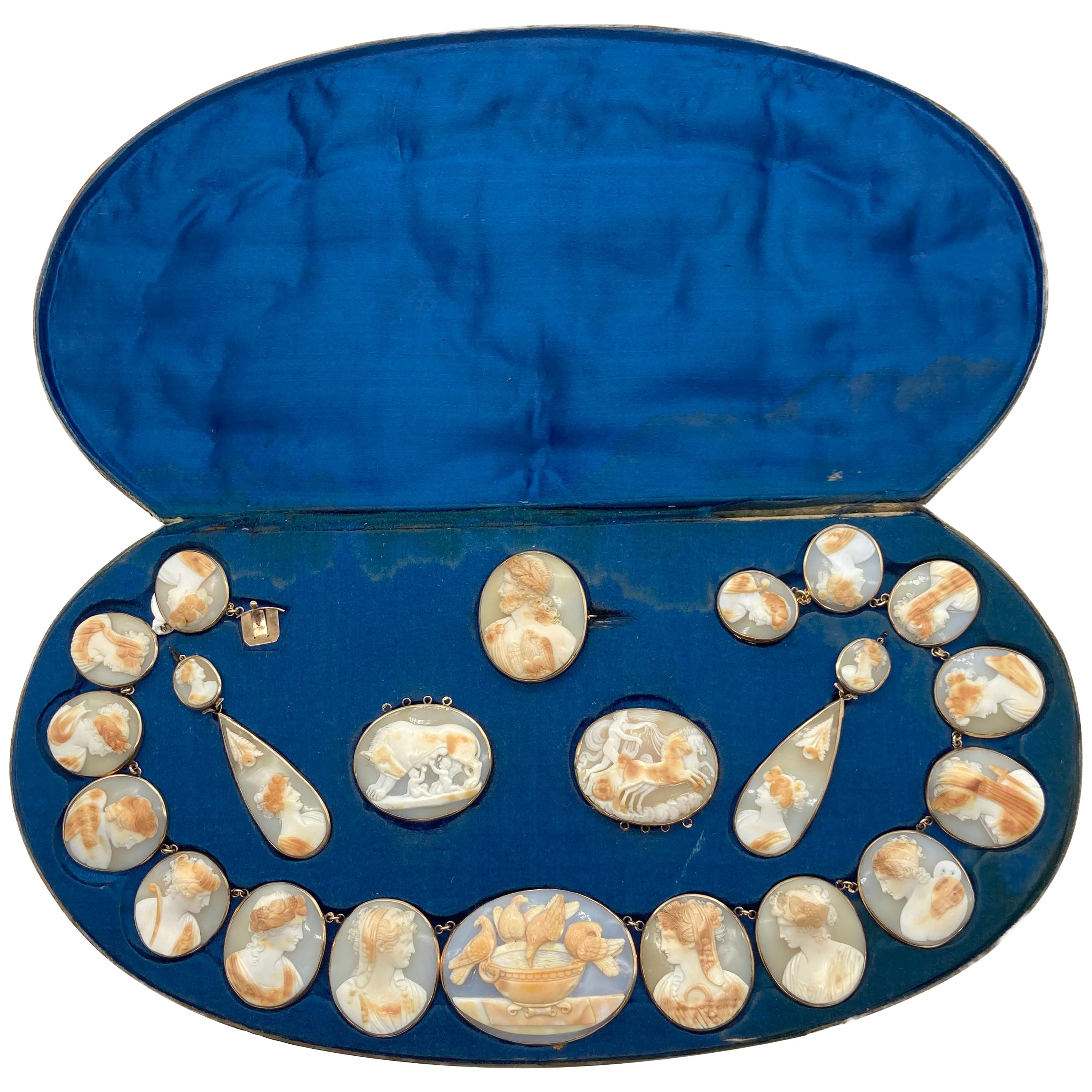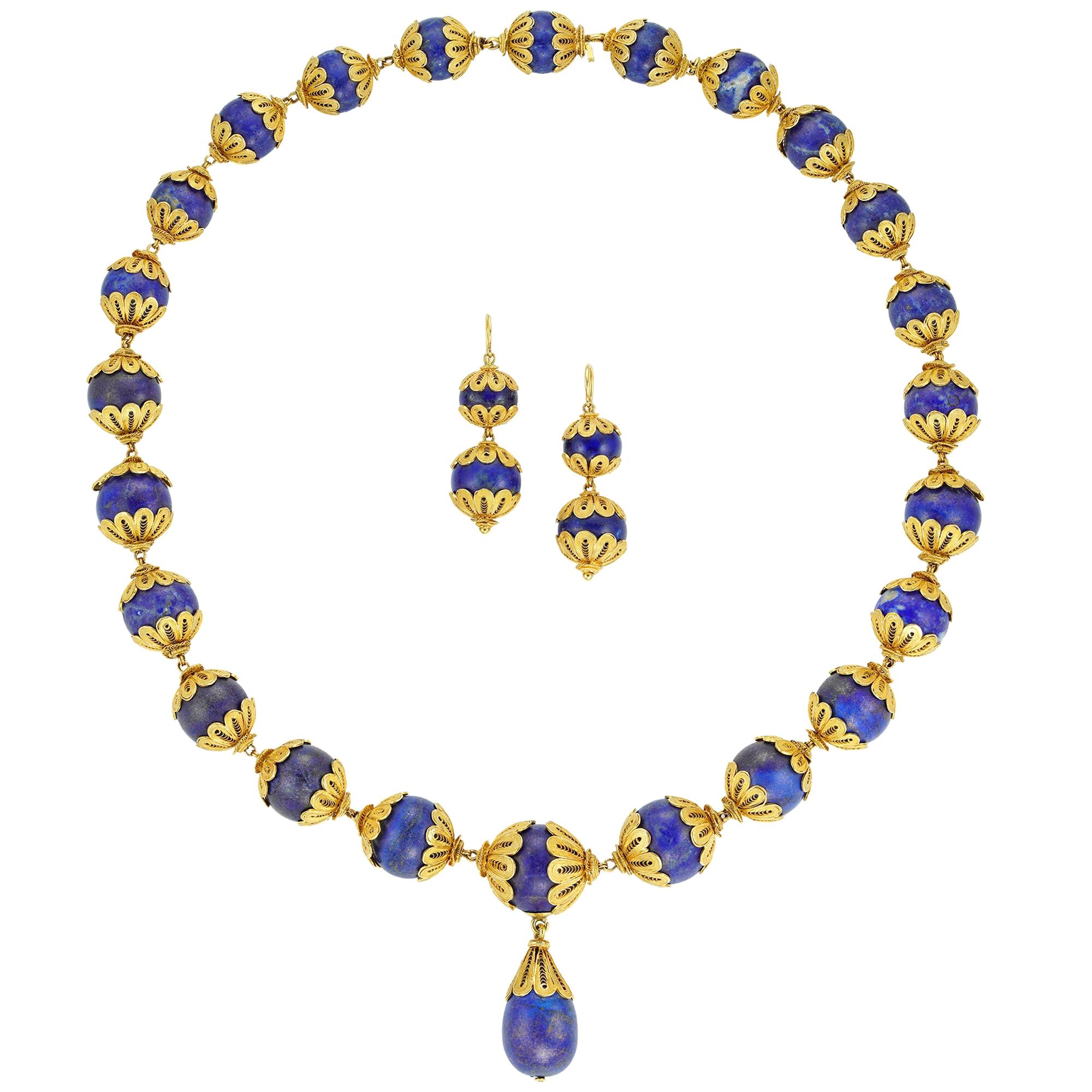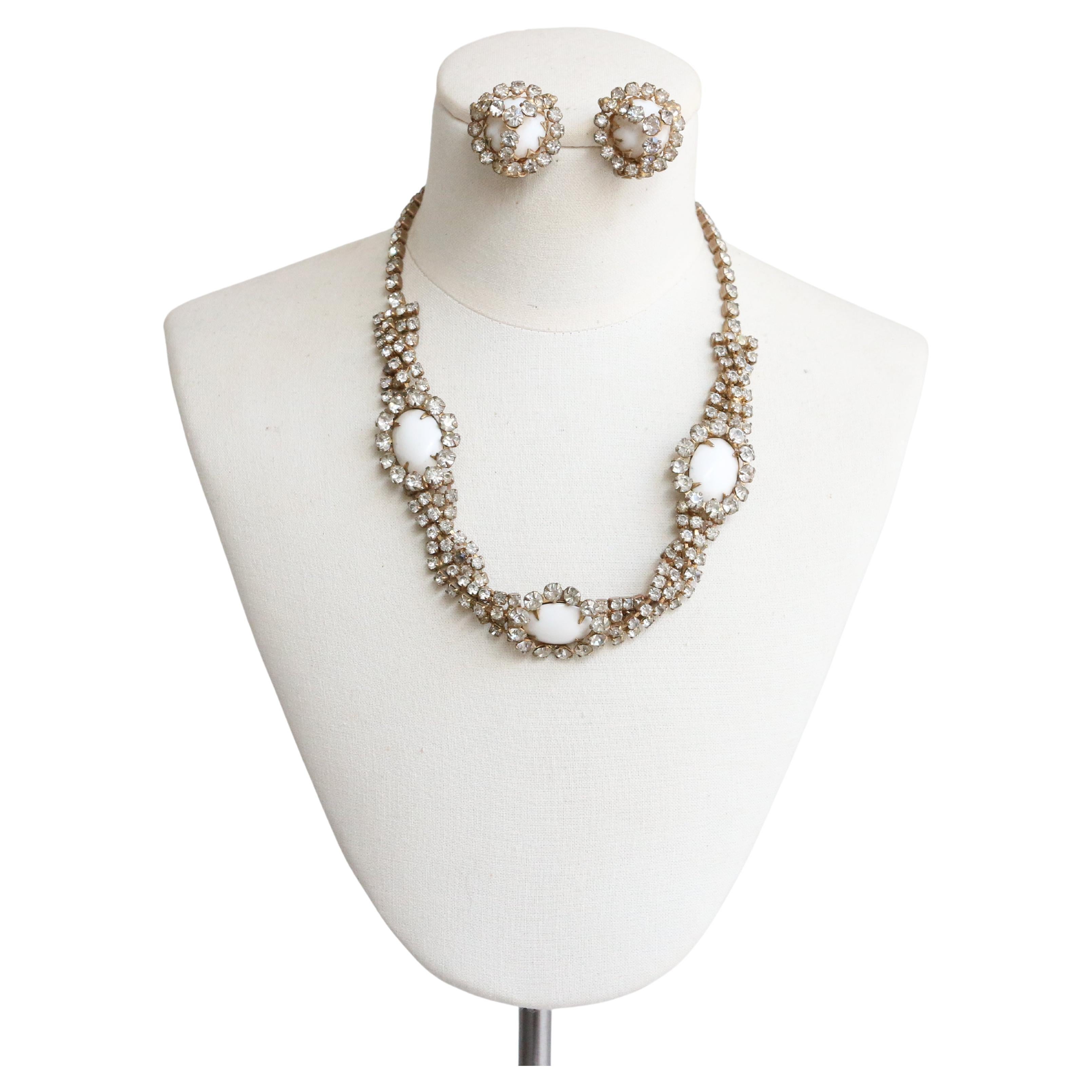Items Similar to Micromosaic Demi-Parure Set, Early 19th Century
Want more images or videos?
Request additional images or videos from the seller
1 of 12
Micromosaic Demi-Parure Set, Early 19th Century
About the Item
Micromosaic demi-parure set composed of a gold necklace and earrings. The necklace is composed of eight micromosaic medallions set in dark red glass. Two gold strands support the micromosaics between them. The subjects of the micromosaic plates are uncommon, as they do not represent ruins but rather baskets of flowers and chariots with birds and butterflies on them. The earrings feature micromosaics of a pansy and a rose.
The micromosaic with a basket of flowers takes up a Roman mosaic motif conserved at the Pio Clementino museum in the Vatican. This mosaic was discovered in 1790 on the Qurinial Hill in Rome. The chariot motif is inspired by a mosaic discovered in the Vetii house in Pompeii.
This demi-parure is presented in a gift box featuring a label affixed by the workshop which reads: Vincent Verdeiro Romain, Via di Condotti Vicimo al corso. The artist is known to have been active from the 19th century until 1864, and is known for his production of small-format micromosaics as well as for a portrait of Pope Pius VII.
Early 19th century. Empire period.
- Metal:
- Sold As:Set of 3
- Style:
- Place of Origin:
- Period:
- Date of Manufacture:1800
- Condition:Wear consistent with age and use.
- Seller Location:Paris, FR
- Reference Number:
About the Seller
5.0
Vetted Seller
These experienced sellers undergo a comprehensive evaluation by our team of in-house experts.
1stDibs seller since 2020
9 sales on 1stDibs
- ShippingRetrieving quote...Ships From: Montesson, France
- Return PolicyA return for this item may be initiated within 3 days of delivery.
More From This SellerView All
- Micromosaic Demi-Parure Set, Early 19th CenturyLocated in Paris, FRMicromosaic demi-parure set composed of a gold necklace and earrings. The double-stranded necklace features seven oval medallions, with two smaller ovals on the drop-shaped pendant earrings. The micromosaics are set in blue glass in the medallions, and each micromosaic depicts a monument from ancient Rome. Micromosaic parure...Category
Antique 1810s French Empire Multi-Strand Necklaces
MaterialsGold
- Gold Necklace with Micomosaic, Early 19th CenturyLocated in Paris, FRA gold necklace and micromosaic. The necklace is composed of seven micromosaic medallions set in dark blue glass. Two gold strands support the micromosaics between them. The subjects...Category
Antique Early 1800s French Empire Multi-Strand Necklaces
MaterialsGold
- Chain Link Necklace with Gold and Enamel Plates, Early 19th CenturyLocated in Paris, FRExceptional gold and enamel necklace called plated or esclavage. The necklace is composed of three enameled gold medallions connected by three separate chains that are accented with ...Category
Antique Early 1800s Swiss Chain Necklaces
MaterialsGold, Enamel
- Mid-19th Century Gold Brooch with MicromosaicLocated in Paris, FRBrooch with a micromosaic set in a gold and royal blue enameled gold setting. Rectangular micromosaic on black onyx representing a spaniel lying in the...Category
Antique 1830s French Brooches
MaterialsGold
- Micromosaic Bracelet, First Half of the 19th Century WorkLocated in Paris, FRGold bracelet with six oval, micromosaic medallions set in black glass. Each micromosaic represents a different Roman edifice: Saint Peter’s Basilica, the Coliseum, the Pantheon, the...Category
Antique 1820s French Link Bracelets
MaterialsGold
- Early 19th Century Gold VinaigretteLocated in Paris, FROval-shaped gold and enamel vinaigrette. The vinaigrette is entirely decorated with a guilloche motif with stylized flower. The hinged lid is decorated in the center with a medallion...Category
Antique 1810s French Boxes and Cases
MaterialsGold, Enamel
You May Also Like
- George III Garnet-Set Demi-ParureLocated in London, GBA George III garnet-set demi-parure, the necklace consisting of four garnet-set foliate clusters linked with articulated garnet-set trefoil-links, 17.5 inches long, the bracelet consisting of seventeen articulated garnet-set trefoil-links 7 inches long, all garnets cut-down set to yellow gold closed-back mount, circa 1800, gross weight 53.0 grams. A charming and detailed Georgian suite...Category
Antique Early 19th Century British George III Link Necklaces
MaterialsGarnet, Yellow Gold, Gold
- Antique 19th Century Neoclassical Shell Cameo Parure Set in Original BoxLocated in New York, NYAn impressive shell cameo parure comprised of necklace, earrings (day-to-night with removable drops), brooch, and 2 bracelet panels (for stitching onto ri...Category
Antique Early 19th Century Italian Neoclassical Link Necklaces
MaterialsGold
- 19th Century Lapis Lazuli Bead and Gold Demi-ParureLocated in London, GBA 19th Century lapis lazuli bead and gold demi-parure, the necklace consisted of twenty four graduated lapis beads measuring from 17.8mm to 13.6mm, with yellow gold filigree decorati...Category
Antique Mid-19th Century English Etruscan Revival Beaded Necklaces
MaterialsLapis Lazuli, Gold, 18k Gold, Yellow Gold
- French 19th Century Garnet 18k Yellow Gold Medallion and Pompom Long NecklaceLocated in Poitiers, FRNecklace in 18 karat yellow gold, eagle head hallmark. Splendid antique gold chain, it is constituted of a double row of cob mesh on which circulates a gold runner...Category
Antique Late 19th Century French Napoleon III Link Necklaces
MaterialsGarnet, Gold, 18k Gold, Yellow Gold
- Vintage 1950's Hattie Carnegie Milk Glass & Rhinestone Demi-Parure SetBy Hattie CarnegieLocated in Cheltenham, GBThis breathtaking 1950's Hattie Carnegie jewellery set, made up of a necklace and clip on earrings, is the perfect set to add a touch of glamou...Category
Vintage 1950s Link Necklaces
- Antique Early 19th Century Cut-Steel NecklaceLocated in Malmö, SECut steel jewelry was at the height of fashion from the mid 1700s well into the 19th century. Originated in the 1700s. Popular from the Georgian through the Victorian eras. To make cut steel, melted horseshoe nails were formed into tiny faceted beads. Those small steel gemstone-like studs were then riveted one-by-one onto a base plate. It was an English invention that quickly travelled throughout the world. Each stud could have up to 15 facets, and in general the finer and older the piece the more facets the studs will have. Improvements in candles meant that grand events and entertaining could take place at night. As diamonds are diamonds and not available for everyone, and everyone wanted to shine, the popularity grew. Cut-steel provided a stylish and popular new jewelry material that could be enjoyed by everyone at all levels of society. It grew beyond a simple imitation to an art in its own right. The manufacturing was complex and the workmanship that was required highly skilled. These were not mass produced objects. The studs were made from decarbonated cast steel, which was case-hardened, then the studs were faceted by cutting against a pewter wheel. Next were then polished with first fine emery and a hard brush, and then by hand with a special putty. Finally they were riveted onto pierced base plates which had to be drilled and cut by hand, too. The main place of cut steel production was Birmingham, England. And there, one manufacturer stood out from all the rest: Matthew Boulton. He had been born in 1728 into the industry — his father manufactured small metal products. But the younger Boulton had a special talent for marrying the latest technology with the latest fashion. He also was continually expanding — he even founded a mint. He wined and dined with dignitaries and advocated for his steel products. Fortuitously, he became quite close with the Russian ambassador to Catherine the Great. When the ambassador toured the mint, Boulton made sure to send the Empress some of his cut-steel necklaces. In 1759, Louis XV “encouraged” the nobility to donate their gold and gemstone jewelry to help fund the Seven Years War. The popularity of cut steel in France may in part have been due to these sumptuary laws which limited who could wear precious metals and diamonds. Either you complied with the law and gave up your family jewels to be melted down for the war chest...Category
Antique Early 19th Century English Early Victorian Link Necklaces
MaterialsSteel
Recently Viewed
View AllMore Ways To Browse
1800 Gold Jewlery
French 19th Century Necklace
Empire Medallion
Flower Link Necklace
French Empire Jewelry
Gold Parure
French Empire Boxes
French Empire Box
Antique Necklace And Earrings
Necklace Parure
Gold Link Necklace With Earrings
Roman Mosaics
Roman Mosaic
Jewellery 1790
Parure Necklace Earrings
Empire Period Jewelry
Butterfly Plate Set
Antique Jewelry Rome
